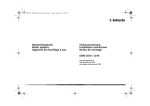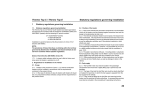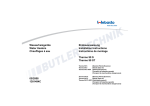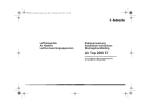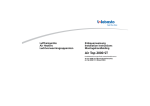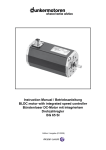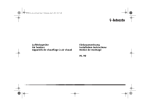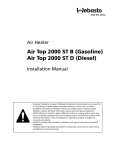Download Webasto Thermo 350 Technical data
Transcript
Th23_EA_degbfr_g.book Seite I Dienstag, 15. Februar 2005 2:03 14 Wasserheizgeräte Water Heaters Appareils de chauffage Einbauanweisung Installation Instructions Instruction de montage Thermo 230 Thermo 300 Thermo 350 Typ/Type Thermo 230/300/350 Thermo 231 Thermo 301 Typ/Type Thermo 231/301 mit Steuergerät 1572D with Control Unit 1572D avec boîtier de commande 1572D 01/2005 Th23_EA_degbfr_g.book Seite III Dienstag, 15. Februar 2005 2:03 14 Thermo 230/231/300/301/350 Improper installation or repair of \/Vebasto heating and cooling systems can cause fire or the leakage of deadly carbon monoxide leading to serious injury or death. To install and repair Webasto heating and cooling systerns you need to have completed a Webasto training course and have the appropriate technical documentation, special tools and special equipment. NEVER try to install or repair Webasto heating or cooling systems if you have not completed a Webasto training course, you do not have the necessary technical skills and you do not have the technical documentation, tools and equiprnent available to ensure that you can complete the installation and repair work properly. ALWAYS carefully follow Webasto installation and repair instructions and heed all WARNINGS. Webasto rejects any liability for problems and damage caused by the system being installed by untrained personnel. La réparation ou l'installation impropre des systèmes de chauffage et de refroidissement Webasto peut conduire à l'incendie de l'appareil ou encore à des fuites mortelles de monoxyde de carbone pouvant entraîner de graves lésions voire même la mort. Pour l'installation ou la réparation des systèmes de chauffage ou de refroidissement Webasto, il est nécessaire d'avoir une formation Webasto, une documentation technique, des outils spécifiques et des équipements particuliers. N'essayez JAMAIS d'installer ou de réparer un système de chauffage ou de refroidissement Webasto si vous n'avez pas suivi avec succès la formation Webasto et obtenu ainsi les capacités techniques indispensables et si vous ne disposez pas de la documentation technique, des outils et des équipements nécessaires à une installation ou à une réparation dans les règles de l'art. TOUJOURS suivre scrupuleusement les instructions Webasto relatives à l'installation et à la réparation des appareils et tenir compte de toutes les MISES EN GARDE. Webasto décline toute responsabilité, en cas de problème ou de dommage causé par un système ayant été installé par du personnel non qualifié. III Th23_EA_degbfr_g.book Seite IV Dienstag, 15. Februar 2005 2:03 14 Thermo 230/231/300/301/350 Inhaltsverzeichnis Contents 1 2 3 4 5 6 7 8 9 10 11 12 13 14 1 2 3 4 5 6 7 8 9 10 11 12 13 14 Gesetzliche Bestimmungen für den Einbau . . . . . . . . . . . . 1 Verwendung / Ausführung . . . . . . . . . . . . . . . . . . . . . . . . . . 3 Einbau . . . . . . . . . . . . . . . . . . . . . . . . . . . . . . . . . . . . . . . . . . 4 Einbaubeispiel für Thermo 230/300/350 . . . . . . . . . . . . . . 11 Einbau Umwälzpumpe . . . . . . . . . . . . . . . . . . . . . . . . . . . . 12 Anschluss an das Kühlsystem des Fahrzeuges . . . . . . . 17 Brennstoffversorgung . . . . . . . . . . . . . . . . . . . . . . . . . . . . 18 Brennluftversorgung . . . . . . . . . . . . . . . . . . . . . . . . . . . . . 19 Abgasleitung . . . . . . . . . . . . . . . . . . . . . . . . . . . . . . . . . . . . 20 Elektrische Anschlüsse . . . . . . . . . . . . . . . . . . . . . . . . . . . 21 Erstinbetriebnahme . . . . . . . . . . . . . . . . . . . . . . . . . . . . . . 28 Wartung . . . . . . . . . . . . . . . . . . . . . . . . . . . . . . . . . . . . . . . . 29 Störungen . . . . . . . . . . . . . . . . . . . . . . . . . . . . . . . . . . . . . . 20 Technische Daten . . . . . . . . . . . . . . . . . . . . . . . . . . . . . . . . 32 Statutory regulations governing installation . . . . . . . . . . . 35 Use / version . . . . . . . . . . . . . . . . . . . . . . . . . . . . . . . . . . . . . 37 Installation. . . . . . . . . . . . . . . . . . . . . . . . . . . . . . . . . . . . . . . 38 Installation example for the Thermo 230 / 300 / 350 heater . . . 45 To install the circulating pump . . . . . . . . . . . . . . . . . . . . . . 46 Connection to the vehicle cooling system. . . . . . . . . . . . . 51 Fuel supply . . . . . . . . . . . . . . . . . . . . . . . . . . . . . . . . . . . . . . 52 Combustion air supply . . . . . . . . . . . . . . . . . . . . . . . . . . . . 53 Exhaust pipe . . . . . . . . . . . . . . . . . . . . . . . . . . . . . . . . . . . . 54 Electrical connections . . . . . . . . . . . . . . . . . . . . . . . . . . . . . 55 Initial start-up . . . . . . . . . . . . . . . . . . . . . . . . . . . . . . . . . . . . 62 Maintenance . . . . . . . . . . . . . . . . . . . . . . . . . . . . . . . . . . . . . 63 Troubleshooting . . . . . . . . . . . . . . . . . . . . . . . . . . . . . . . . . . 64 Technical data . . . . . . . . . . . . . . . . . . . . . . . . . . . . . . . . . . . 66 Sommaire 1 2 3 4 5 6 7 8 9 10 11 12 13 14 IV Dispositions légales concernant le montage . . . . . . . . . . 69 Utilisation / version . . . . . . . . . . . . . . . . . . . . . . . . . . . . . . . 71 Installation . . . . . . . . . . . . . . . . . . . . . . . . . . . . . . . . . . . . . 72 Exemple d'installation pour le Thermo 230/300/350 . . . . 79 Installation de la pompe de circulation . . . . . . . . . . . . . . . 80 Raccordement au circuit de refroidissement du véhicule 85 Alimentation en carburant . . . . . . . . . . . . . . . . . . . . . . . . . 86 Alimentation en air de combustion . . . . . . . . . . . . . . . . . . 87 Conduite d'échappement . . . . . . . . . . . . . . . . . . . . . . . . . . 88 Branchements électriques. . . . . . . . . . . . . . . . . . . . . . . . . 89 Première mise en service . . . . . . . . . . . . . . . . . . . . . . . . . 96 Entretien . . . . . . . . . . . . . . . . . . . . . . . . . . . . . . . . . . . . . . . . 97 Dysfonctionnements . . . . . . . . . . . . . . . . . . . . . . . . . . . . . 98 Caractéristiques techniques . . . . . . . . . . . . . . . . . . . . . . . . 100 Th23_EA_degbfr_g.book Seite 35 Dienstag, 15. Februar 2005 2:03 14 Thermo 230/231/300/301/350 1 Statutory regulations governing installation Statutory regulations governing installation 1.1. Statutory regulations governing installation The Thermo 230 / Thermo 231 / Thermo 300 / Thermo 301 / Thermo 350 heater has been type-tested and approved in accordance with EC Directives 72/245/EEC (EMC) and 2001/56/EC (heater) with the following EC permit numbers: e1*72/245*95/54*1010*XX e1*2001/56*0007*00 for Thermo 230 e1*2001/56*0008*00 for Thermo 300 e1*2001/56*0009*00 for Thermo 350 e1*2001/56*0010*00 for Thermo 231 e1*2001/56*0011*00 for Thermo 301 Installation is governed above all by the provisions in Annex VII of Directive 2001/56/EC. NOTE: The provisions of these Directives are binding within the territory governed by EU Directive 70/156/EEC and should similarly be observed in countries without specific regulations. (Extract from Directive 2001/56/EC Annex VII) 1.7.1. A clearly visible indicator within the user's field of vision must show when the heater is switched on or off. 2. Regulations for installation in the vehicle 2.1. Scope 2.1.1.Subject to the provisions of paragraph 2.1.2, internal combustion heaters must be installed in accordance with the requirements contained in this Annex. 2.1.2.In the case of class O vehicles of class O (trailers) with heaters for liquid fuel, it is presumed that these vehicles comply with the requirements in this Annex. 2.2. Position of the heater 2.2.1.Parts of the vehicle body and other components in the immediate vicinity of the heater must be protected against excessive heat and the danger of contamination by fuel or oil. 2.2.2.The internal combustion heater must not pose a fire hazard even when overheated. This requirement is deemed to have been met if care is taken during installation to ensure an adequate distance from all parts, as well as adequate ventilation and if fire-resistant materials or heat shields are used. 2.2.3.In class M2 and M3 vehicles the heater must not be installed in the passenger cabin. A device in a sealed cover, which also meets the requirements set out in paragraph 2.2.2, may be used, however. 2.2.4.The plate mentioned in paragraph 1.4 (model plate) or a duplicate thereof ( duplicate model plate ) must be fitted in such a way that it is still clearly legible when the heater has been installed in the vehicle. 2.2.5. When positioning the heater, all reasonable precautions must be taken to minimise the risk of personal injury or damage to items in the vehicle. 2.3. Fuel supply 2.3.1.The fuel filler neck must not be located in the passenger compartment and must have a tightly fitting cap to prevent any fuel leaks. 2.3.2.The type of fuel and the fuel filler neck must be clearly identified on heaters for liquid fuel, for which the fuel supply is separate from the fuel supply for the vehicle. 2.3.3.A sign must be affixed to the fuel filler neck warning that the heater must be switched off before refuelling. An identical warning must also be included in the manufacturer's operating instructions. 35 Th23_EA_degbfr_g.book Seite 36 Dienstag, 15. Februar 2005 2:03 14 Statutory regulations governing installation 2.4. Exhaust system 2.4.1.The exhaust outlet must be positioned in such a way that exhaust fumes cannot get into the interior of the vehicle through ventilation devices, hot-air inlets or open windows. 2.5. Combustion air inlet 2.5.1.The air for the combustion chamber of the heater must not be extracted from the passenger cabin of the vehicle. 2.5.2.The air inlet must be positioned in such a way that it cannot be obstructed by other objects. 2.6. Hot air inlet 2.6.1.The supply of heating air must consist of either fresh air or recirculated air and must be taken from a clean area which cannot be contaminated by exhaust fumes from the engine, the internal combustion heater or any other source in the vehicle. 2.6.2.The inlet line must be protected by a grating or other suitable means. 2.7. Hot air outlet 2.7.1.Hot air lines within the vehicle must be positioned or protected in such a way as to exclude all risk of injury or damage caused by direct contact. 2.7.2.The air outlet must be positioned or protected so that it cannot be obstructed by other objects. 2.8. Automatic control of the heating system When the engine stops, the heating system must cut out automatically and the fuel supply must be stopped within 5 seconds. The heating system may remain in operation if a manual unit has already been activated. 36 Thermo 230/231/300/301/350 IMPORTANT Failure to follow the installation instructions and the notes contained therein will lead to all liability being refused by Webasto The same applies if repairs are carried out incorrectly or with the use of parts other than genuine spare parts. This will result in the invalidation of the type approval for the heater and therefore of its homologation / EC type licence. 1.2. Provisions relating to the installation in rail vehicles For heater models Thermo 230 / 300 /350 Rail designed for installation in rail vehicles, a design certification acc. to § 33 EBO (= Federal Railway Authority) has been issued with the following approval number: EBA 32AZ3/0141/04. Particular attention must be given to incidental provision 1.6 of the design certification: Should the manufacturer, operator or service technician gain knowledge of any accidents and damage (caused by fire, explosion, escape of Diesel fuel or heating oil EL) that may have occurred despite proper use of the heater, he is required to immediately notify the certifying body thereof. Th23_EA_degbfr_g.book Seite 37 Dienstag, 15. Februar 2005 2:03 14 Thermo 230/231/300/301/350 2 Use / version Use / version 2.1. Use of the water heaters The Webasto Thermo 230/231/300/301/350 water heaters are used in connection with the vehicle's own heating system 2.2. – to heat the passenger cabin, – to defrost the vehicle windows and – to preheat water-cooled engines. Water heater for “diesel” with 23 kW heat current (20000 kcal/h) Versions Thermo 230 Thermo 231 The water heaters operate independently of the engine and are connected to the cooling system, the fuel system and the electrical system of the vehicle. The heater is approved for heating the passenger cabin or the driver’s cab, but not to heat a cargo space used to transport hazardous substances. NOTE: The Thermo 230/300/350 heaters are only licensed for horizontal installation.The Thermo 231/301 heaters are licensed for vertical and horizontal installation. Water heater for “diesel” with 23 kW heat current (20000 kcal/h) Thermo 300 Water heater for “diesel” with 30 kW heat current (26000 kcal/h) Thermo 301 Water heater for “diesel” with 30 kW heat current (26000 kcal/h) Thermo 350 Water heater for "diesel" fuel with 35 kW heat current (30000 kcal/h) The water heaters are designed for 24 V. On request, and depending on the configuration, the heater may be equipped with a nozzle holder preheating system. 37 Th23_EA_degbfr_g.book Seite 38 Dienstag, 15. Februar 2005 2:03 14 Installation 3 Installation IMPORTANT – The statutory regulations governing installation on pages 35 and 36 must be adhered to. – If the water heater is to be operated in a separately installed heating system, prior to installation an installation planning report must always be submitted to Webasto for approval. If this approval is not obtained, all warranty and liability claims will be void. The water heater has been designed, tested and approved for specific bus requirements. NOTE: Check the installation situation of the relevant vehicle type. 3.1. Installation location The heater and circulating pump are to be integrated into the cooling system (or in a separate heating system). The heater must be installed in as low a position as possible to allow the heater and circulating pump to be bled automatically. This is particularly important as the circulating pump is not self-priming. If it is not possible to install the heater in the vehicle’s engine bay it may be installed in a box. The installation box must have sufficient external ventilation to ensure that the maximum temperature of 85°C is not exceeded in the box. Bear in mind the space required for servicing accessibility (for example for removing the combustion chamber) (see Figures 1, 2, 5, and 10) when installing the heater. 38 Thermo 230/231/300/301/350 3.1.1. Installation Location in Rail Vehicles When the heater is to be installed in rail vehicles, it should be installed either in the engine room (e.g. locomotive) or underfloor in an installation box at the wagon body (e.g. railcar). Other installation locations require Webasto's approval in writing. NOTE No antivibration mounts must be used for securing the heater in rail vehicles. Th23_EA_degbfr_g.book Seite 39 Dienstag, 15. Februar 2005 2:03 14 Thermo 230/231/300/301/350 Installation 1 2 3 4 6 7 8 12 11 9 1 2 3 4 5 6 7 8 9 10 11 12 5 CO2 setting Combustion air intake Exhaust fume outlet Fuel intake Fuel discharge Space required to remove the burner chamber Coolant intake Temperature limiter Swivel range, at least approx. 25° Max. swivelled burner Coolant outlet Temperature sensor 10 Fig. 1: Dimensions of the Thermo 230 / 300 / 350 heater (horizontal installation) 39 Th23_EA_degbfr_g.book Seite 40 Dienstag, 15. Februar 2005 2:03 14 Installation Thermo 230/231/300/301/350 610 1 415 ø38 ca 226 2 3 6 ca.440 26,5 4 302,5 382 ø70,3 ca.160 5 7 8 ca.145 200 12 11 ca. 25° ca.440 9 10 Fig. 2: 40 Dimensions of the Thermo 230 / 300 / 350 Rail heater 1 2 3 4 5 6 7 8 9 10 11 12 CO2 setting Combustion air intake Exhaust fume outlet Fuel intake Fuel discharge Space required to remove the burner chamber Coolant intake Temperature limiter Swivel range, at least approx. 25° Max. swivelled burner Coolant outlet Temperature sensor Th23_EA_degbfr_g.book Seite 41 Dienstag, 15. Februar 2005 2:03 14 Thermo 230/231/300/301/350 Installation 3.2. To install the Thermo 230 / 300 / 350 heater The heater may be secured either with four screws M8 (Figure 4/1) or with four screws and nuts (Figure 4/2). Fig. 3: Horizontal installation position 1 1 2 2 2 2 Fig. 4: 1 D 1 Hole pattern for Thermo 230 / 300 / 350 heater 4.5 mm diameter for using M4 screws, 2.9 mm diameter for using B3.9 self-tapping screws 41 Th23_EA_degbfr_g.book Seite 42 Dienstag, 15. Februar 2005 2:03 14 Installation Thermo 230/231/300/301/350 2 4 6 9 5 7 3 10 12 11 8 Fig. 5: 42 Dimensions of the Thermo 231 / 301 heater (vertical installation) 1 1 2 3 4 5 6 7 8 9 10 11 12 CO2 setting Combustion air intake Exhaust fume outlet Fuel intake Fuel discharge Space required to remove the burner chamber Coolant intake Temperature limiter Swivel range, at least approx. 25° Max. swivelled burner Coolant outlet Temperature sensor Th23_EA_degbfr_g.book Seite 43 Dienstag, 15. Februar 2005 2:03 14 Thermo 230/231/300/301/350 Installation 3.3. To install the Thermo 231 / 301 heater The heater is to be secured with four M8 screws (Figure 7), body washers and nuts. IMPORTANT The heat transfer base must be supported on a stable surface connected to the floor of the car. The securing screws are designed to fix the heater in position, not to suspend it. Fig. 7: Fig. 6: Hole pattern for the Thermo 231 / 301 heater Vertical installation position 43 Th23_EA_degbfr_g.book Seite 44 Dienstag, 15. Februar 2005 2:03 14 Installation 3.4. Model plate The model plate must be protected from damage and must be clearly legible when the heater is installed (otherwise a duplicate model plate must be used). Thermo 230/231/300/301/350 3.5. Additional Type Plate Heaters approved for use in rail vehicles are additionally identified by the type plate illustrated below: Feel the drive Eisenbahn-BundesamtBauartzulassung Nr: EBA 32AZ3/0141/04 Fig. 8: Model plate for Thermo 230 Fig. 9: 44 Additional Type Plate Th23_EA_degbfr_g.book Seite 45 Dienstag, 15. Februar 2005 2:03 14 Thermo 230/231/300/301/350 4 Installation example for the Thermo 230 / 300 / 350 heater Installation example for the Thermo 230 / 300 / 350 heater Water heating circuit – wall heater and roof duct heating system 1 2 3 4 5 6 7 8 5 Wall heater with blower Heat exchanger at entry point Heater Circulating pump Roof heat exchanger Vehicle engine Driver’s position heating system Control element 3 1 4 6 7 1 1 2 1 9 8 Vorlauf Supply Rücklauf Return Fig. 10: Installation example for the Thermo 230 / 300 / 350 heater 45 Th23_EA_degbfr_g.book Seite 46 Dienstag, 15. Februar 2005 2:03 14 To install the circulating pump 5 Thermo 230/231/300/301/350 To install the circulating pump The circulating pump must be installed as shown in Figures 11 and 12, Figure 14 and 15, Figure 17 and 18 or Figures 20 and 21. Note the installation position. NOTE: The pump ports and connection lines from the water intake and water outlet must be flush (no stress). 5.1. U 4814 circulating pump Fig. 12: Hole pattern for the stand for U 4814 circulating pump Delivery rate (with water at 20°C) ∆ Fig. 11: U 4814 circulating pump Installation position 46 Flow resistance (with the pump stopped) Fig. 13: Delivery rate and flow resistance U 4814 circulating pump Th23_EA_degbfr_g.book Seite 47 Dienstag, 15. Februar 2005 2:03 14 Thermo 230/231/300/301/350 5.2. To install the circulating pump Aquavent 5000 S circulating pump 99,5 249 53 60 32 131,5 38 31 38 23 110 225 Br- Sw+ 0-90° 90° Fig. 14: Aquavent 5000 S circulating pump Installation position Fig. 15: Hole pattern for the stand for Aquavent 5000 S circulating pump Delivery rate (with water at 20°C) Flow resistance (with the pump stopped) Fig. 16: Delivery rate and flow resistance Aquavent 5000 S circulating pump 47 Th23_EA_degbfr_g.book Seite 48 Dienstag, 15. Februar 2005 2:03 14 To install the circulating pump 5.3. Thermo 230/231/300/301/350 U 4851 circulating pump 279 115 53 60 32 31 500 38 38 23 110 63 6,5 24 100 * 90° 0-90° * Clamping area of the stand clamp Fig. 17: U 4851 circulating pump Installation position 85 97,5 Br- Sw+ Fig. 18: Hole pattern for the stand for U 4851 circulating pump Delivery rate (with water at 20°C) Flow resistance (with the pump stopped) Fig. 19: Delivery rate and flow resistance U 4851 circulating pump 48 Th23_EA_degbfr_g.book Seite 49 Dienstag, 15. Februar 2005 2:03 14 Thermo 230/231/300/301/350 5.4. To install the circulating pump Aquavent 6000 S circulating pump 284 53 115 180,5 60 32 31 500 38 38 23 110 63 0-90° 6,5 24 100 * 85 90° 97,5 Br- Sw+ 122,5 Fig. 21: Hole pattern for the stand for the Aquavent 6000 S circulating pump * Clamping area of the stand clamp Fig. 20: Aquavent 6000 S circulating pump Installation position NOTE: When connecting the circulating pump is must be ensured that the volume flow does not drop below 1800 l/h ! Delivery rate (with water at 20°C) Flow resistance (with the pump stopped) Fig. 22: Delivery rate and flow resistance Aquavent 6000 S circulating pump 49 Th23_EA_degbfr_g.book Seite 50 Dienstag, 15. Februar 2005 2:03 14 To install the circulating pump 5.5. Motor for the U 4851 / Aquavent 6000 S circulating pump The U 4851 / Aquavent 6000 S circulating motor is fitted with a brushless motor. 5.5.1. Soft start The motor starts slowly to protect its material. It does not reach its maximum speed for approx. 5 seconds. 5.5.2. Dry running protection (U 4851 only) A dry running protection is integrated in the motor for speeds >3300 rpm. If the motor consumes less than 4 A of current in a timeframe of 1018 revolutions, it assumes that it is running dry. The motor is switched off by the error motor (after approx. 10 seconds of operation or approx. 15 seconds after it was switched on). 5.5.3. Blocking protection If the speed falls to below 57 rpm the motor is switched off after approx. 1 second by the error mode. If the motor does not complete a full revolution in 1 seconds despite the medium flow, it is also switched off by the error mode. 5.5.4. Error mode The error mode switches off the motor in the event of faults. The motor is switched to power-saving sleep mode by the error mode after approx. 5 seconds. 5.5.5. Sleep mode In sleep mode the internal consumers of the motor’s electronics are switched off. The current consumption in this mode is then < 2 mA. 50 Thermo 230/231/300/301/350 5.5.6. To reactivate the motor The motor can be reactivated from sleep mode. This is done by disconnecting it from the power supply for approx. 2 minutes. When the voltage supply is reconnected the motor will restart in soft start mode. 5.5.7. Reverse polarity protection The motor does not have polarity reversal protection. The motor is protected from polarity reversal by the wiring harness and a 25 A fuse. Th23_EA_degbfr_g.book Seite 51 Dienstag, 15. Februar 2005 2:03 14 Thermo 230/231/300/301/350 6 Connection to the vehicle cooling system Connection to the vehicle cooling system The heater is connected to the vehicle cooling system as shown in Figures 1, 2, 5 and 10. The system must contain at least 10 litres of coolant. A minimum of 20% of a good quality antifreeze should be maintained in the heating circuit of the heater at all times. The water hoses supplied by Webasto must always be used. If you do not use these hoses, the hoses that you do use must comply with DIN 73411. The hoses must be installed without kinks and (to ensure perfect bleeding of the heater) rising if possible. Hose connections must be supported by hose clips to prevent them slipping. off when there is a lack of coolant or the pump impeller is obstructed; it may be restarted after approximately 2 minutes. Also in the case of Thermo 230/231/300/301/350 heaters featuring control unit SG 1572 D in combination with a programmed check of the circulating pump, will the heater be switched off when there is a lack of coolant. NOTE: The specified tightening torques of the hose clamps used must be complied with. Only pressure valves with an opening pressure of min. 0.4 bar and max. 2.0 bar may be used in the vehicle’s cooling system or in a separate heating system. The cooling system must be bled carefully before using the heater for the first time or after replacing the coolant. The heater and lines should be installed in such a way as to ensure static bleeding. Perfect ventilation can be identified by the circulating pump operating almost silently. Poor bleeding may cause the resetting temperature limiter to trip whilst the heater is operating. When using circulating pump U 4851, approximately 15 seconds after switch-on the circulating pump is automatically switched off when there is a lack of coolant or the pump impeller is obstructed; it may be restarted after approximately 2 minutes. When using Aquavent 6000 S circulating pump, approximately 45 seconds after switch-on the circulating pump is automatically switched 51 Th23_EA_degbfr_g.book Seite 52 Dienstag, 15. Februar 2005 2:03 14 Fuel supply 7 Fuel supply The fuel is taken from the vehicle fuel tank or from a separate fuel tank. 7.1. Fuel lines Fuel lines are to be installed with a gradient wherever possible to prevent air inclusions. Connections within the line are to be secured with hose clips if no mechanical screw connectors are used. If fuel hoses are used, the hoses supplied by or available from Webasto must generally be used. If you do not use these hoses, the fuel hoses that you do use must comply with DIN 73379. Fuel hoses must not be kinked or twisted and must be secured with clips approx. every 25 cm. Materials commonly used in automobile manufacture, e.g. steel and plastic lines made of plasticized, light-resistant and temperaturestabilized PA 11 or PA 12 (e.g. Mecanyl RWTL) as per DIN 73378 may also be used for fuel lines taking into account the suitable connection system in each case. The following must be observed for the installation of fuel lines: – The lines must be protected from the effects of high temperatures. IMPORTANT! The external casing on the heater may reach the ignition temperature of diesel if it is operated without coolant. – The lines must be protected from stone damage. – Dripping or evaporating fuel must not be allowed either to accumulate or to ignition hot parts or electrical equipment It is not permissible to install a shut-off device in the return line! IMPORTANT Operation with a closed return line will damage the fuel pump. Fuel may escape. Danger of fire! 52 Thermo 230/231/300/301/350 Unsupported fuel lines must be secured to prevent them sagging. Do not install an additional fuel pump. See pages 35 and 36 for the statutory regulations. 7.1.1. Maximum dimensions of the fuel lines: – Internal diameter for intake and return line: 6 mm (other diameters to order). – Maximum line length for each intake and return line: 10 m – Maximum intake height: 2 m (we recommend the installation of a foot valve if the max. intake height is used) – Max. permissible suction height: 2 m – Max. permissible pressure in flow and return lines: 0.3. bar 7.2. Fuel filter A fuel filter supplied or approved by Webasto must be used (check the flow direction). To avoid malfunctions the filter or filter insert is to be replaced before the start of the cold weather. Th23_EA_degbfr_g.book Seite 53 Dienstag, 15. Februar 2005 2:03 14 Thermo 230/231/300/301/350 8 Combustion air supply Combustion air supply Under no circumstances may the combustion air be taken from areas occupied by people. The combustion air intake opening must not point in the direction of travel. It must be located so that it cannot become clogged with dirt or snow and cannot suck in splashing water. Maximum dimensions of the air intake line: – Internal diameter: 55 mm – Maximum line length: 5 m without the exhaust extension – Maximum bends: 270° – Total length of air intake line and exhaust pipe max. 5m The combustion air intake must not be routed above the exhaust outlet. NOTE: If the combustion air intake line cannot be installed so that it slopes downwards, a water drain hole with a diameter of 4 mm is to be made at its lowest point. If the heater is installed in a general installation space near the vehicle’s fuel tank, the combustion air must be taken in from the outside and the exhaust fumes discharged into the atmosphere. The openings must be splash-proof. A ventilation opening is required if the heater is installed in an enclosed box. Thermo 230 / Thermo 231 / Thermo 300 / Thermo 301 30 cm2 Thermo 350 35 cm2 The size of the ventilation opening must be increased subject to consultation with Webasto if the temperature in the box exceeds the permitted ambient temperature of the heater (see Technical data). 53 Th23_EA_degbfr_g.book Seite 54 Dienstag, 15. Februar 2005 2:03 14 Exhaust pipe 9 Exhaust pipe The opening of the exhaust pipe must not point towards the front of the vehicle. The exhaust pipe opening must be located so that it cannot become clogged with snow and mud. Rigid pipes of unalloyed or alloyed steel with a minimum wall thickness of 1.0 mm or flexible piping of alloyed steel only must be used as exhaust line. The exhaust pipe is secured to the heater using a clamping collar, for example. See the statutory regulations for other requirements. Maximum dimensions of the exhaust pipe: – Internal diameter: 70 mm – Maximum line length: 5 m without the combustion air intake extension – Total length of air intake line and exhaust pipe max. 5m – Maximum bend: 270° NOTE: If the exhaust line is installed near heat-sensitive parts, it must be insulated. 54 Thermo 230/231/300/301/350 Th23_EA_degbfr_g.book Seite 55 Dienstag, 15. Februar 2005 2:03 14 Thermo 230/231/300/301/350 10 Electrical connections Electrical connections 10.1. Heater connection IMPORTANT HIGH VOLTAGE: Danger of death. Disconnect the plug connection to the vehicle before you open the heater. Make the electrical connections to the heater as shown in Figure 23: Automatic circuit diagram for water heaters type Thermo 230, Thermo 231, Thermo 300, Thermo 301 and Thermo 350 Any plug designs that differ from the standard versions (Figures 23 and 24) are to be requested separately from Webasto. Use the specified cable cross-sections. Connect the negative and positive terminals of the heater controller direct to the battery. 10.2. Connecting the controls The heater can be switched on and off using the following Webasto controls: – Switch, see automatic circuit diagram Figure 23 – Timer, see circuit diagram Figure 24 10.3. Control module The control module is installed in the heater. 10.4. Economy mode The connection of the switch for economy mode is shown in the automatic circuit diagram, Figures 23 and 24. 55 Th23_EA_degbfr_g.book Seite 56 Dienstag, 15. Februar 2005 2:03 14 Electrical connections Thermo 230/231/300/301/350 10.5. Water Temperature Control Thresholds:: Heater Auxiliary heating 0->1 1->control idle period Thermo 230.032 Thermo 300.031 Thermo 350.032 Thermo 230.126 Rail Thermo 300.126 Rail Thermo 350.126 Rail 10.5.1. Parking heating 0->1 1->control idle period Economy setting 0->1 1->control idle period Comment 78 85 70 85 55 70 Standard data record 70 85 45 60 5 20 Engine start-up (>+60°C) Preheat + heat preservation (>+40°C) Freeze protection (>+0°C) Pin Assignment of Cable Harness for Control Thresholds, Models Thermo 230 / Thermo 300 / Thermo 350 (Standard):: Control unit function Auxiliary heating Parking heating Economy setting on/off on on on volts Connector 24 V X3 24 V X1 24 V X3 Pin 5 5 4 Comment only in conjunction with parking heater switch connecting wire to control unit only in conjunction with parking heater NOTE: Auxiliary heating has priority over the economy setting! 10.5.2. Pin Assignment of Cable Harness for Control Thresholds, Models Thermo 230.126 / Thermo 300.126 / Thermo 350.126 (Rail):: Control unit function Auxiliary heating Parking heating Economy setting on/off on on on volts 24 V 24 V 24 V Connector X3 X3 X3 NOTE: Auxiliary heating has priority over the economy setting! 56 Pin 3 5 2 Comment only in conjunction with parking heater switch connecting wire to control unit only in conjunction with parking heater Th23_EA_degbfr_g.book Seite 57 Dienstag, 15. Februar 2005 2:03 14 Thermo 230/231/300/301/350 10.6. Legend for circuit diagrams ➀ Diagnostic connector ➁ ➂ Digital timer P: with positive at connection 10= Continuous operation with immediate heating Connection 10 open = Variable heating duration can be programmed (10 min to 120 min); Default setting 120 min Plug assignment: Plug assignment D1 D2 D3 D4 F1 F2 ➃ ➄ 4-core cable 0.75 gr 0.75 or 0.75 gn 0.75 br Not occupied Not occupied 7-core cable 0.75 rt 0.75 or 0.75 bl 2.0 br 2.0 sw 2.0 rt/ws Electrical connections Cable cross-sections < 7.5 m 7.5 - 15 m 0.75 mm2 1.5 mm2 1.0 mm2 1.5 mm2 1.5 mm2 2.5 mm2 2.5 mm2 4.0 mm2 4.0 mm2 6.0 mm2 Cable colours bl br ge gn gr or rt sw vi ws blue brown yellow green grey orange red black violet white with connection to terminal 61 heating mode Option 57 Th23_EA_degbfr_g.book Seite 58 Dienstag, 15. Februar 2005 2:03 14 Electrical connections Item Designation Thermo 230/231/300/301/350 Comment Item Designation Comment S3 External activation Circulating pump A1 Heater A2 Control module SG 1572 D B1 Flame sensor Check polarity S4 Switch Economy mode B2 Temperature sensor Any polarity S5 Switch Auxiliary heating mode B3 Temperature limiter S6 Switch Filter heater on B4 Thermostat For nozzle preheating T Temperature switch Filter heater B5 Thermostat Alternative to B3 U1 Ignition spark generator B6 Thermostat For vertical installation (MV Y1) U2 Ignition electrodes Filter heater W1 Wiring harness (1) Heating cartridge For nozzle preheating W2 Wiring harness (2) Blade-type fuse DIN 72581 Part 3 W3 Wiring harness (3) Plug connector, 6-pin E E1 F1 Fuse 25 A Switch F2 Fuse 25 A Blade-type fuse DIN 72581 Part 3 A F3 Fuse 5 A Blade-type fuse DIN 72581 Part 3 C Plug connector, 1-pin Blade-type fuse DIN 72581 Part 3 D Plug connector, 4-pin Blade-type fuse DIN 72581 Part 3 F Plug connector, 2-pin Blade-type fuse DIN 72581 Part 3 O Plug connector, 2-pin F4 F5 F6 Fuse 25 A Fuse 5 A Fuse 5 A F7 Fuse 5 A Blade-type fuse DIN 72581 Part 3 Q Plug connector, 2-pin H1 Light Indicator X1 Plug connector, 6-pin H2 Light Flame indicator X2 Plug connector, 2-pin H4 Heating symbol on the display Power-on indicator (in item P) X3 Plug connector, 8-pin X4 Plug connector, 12-pin X5 Plug connector, 4-pin K4 Relay M1 Motor Combustion air fan X6 Plug connector, 4-pin M2 Motor Circulating pump X7 Plug connector, 7-pin P Digital timer, standard (1531) For programmed operation Y1 Solenoid valve S1 Switch 58 ON/OFF Th23_EA_degbfr_g.book Seite 59 Dienstag, 15. Februar 2005 2:03 14 Thermo 230/231/300/301/350 Electrical connections 58 75 (15) 61 30 58 75 (15) 61 30 A F3 F1 F2 S4 C 1 X3 5 6 3 3 4 3 3 3 2 3 1 2 3 6 5 4 4 1 D 3 W2 X1 S1 S3 W1 A 1 sw 5 5 or 1 3 4 2,0 mm² rt/ws 2,0 mm² rt F D 1 2 3 1 2 4 1 2 34 F 3 1 2 4 X1 2 2 M1 U1 B6 B3/B5 B2 6 2,0 mm² br 6 H1 M 2 - U1 ϑ B6 M E1 2,0 mm² sw U2 31 6 X3 1 35 7 2 B4 + SE M2 5 X2 1 A1 3 4 1 A2 X2 E1 2 bl C A2 B1 Y1 1 M1 Y1 B3 ϑ B5 ϑ 2 4 6 8 ϑ B2 H2 B1 A1 31 Fig. 23: System circuit for Thermo 230 / 231 / 300 / 301 / 350 24V with control module 1572 D, with switch, for legend see page 57 and 58 59 Th23_EA_degbfr_g.book Seite 60 Dienstag, 15. Februar 2005 2:03 14 Electrical connections Thermo 230/231/300/301/350 58 75 (15) 61 30 58 75 (15) 61 30 A 4 F3 F1 F2 S4 2 1 X1 P 2 H4 5 6 3 3 4 3 3 3 2 3 1 D 3 W2 11 10 C 1 X3 S3 8 W1 A 1 sw 5 5 or 1 3 2,0 mm² rt/ws F D 1 2 3 1 2 4 1 7 4 4 2,0 mm² rt 2 1 X1 2 2 U1 B6 B3/B5 B2 6 2,0 mm² br 6 A1 B4 M 2 5 6 X3 1 35 7 2 + SE M2 3 4 X2 1 E1 2 1 A2 X2 A2 B1 Y1 1 bl C - U1 ϑ B6 M E1 2,0 mm² sw U2 31 2 4 X4 M1 34 F 3 H1 12 1 2 3 6 5 4 M1 Y1 B3 ϑ B5 ϑ 2 4 6 8 ϑ B2 H2 B1 A1 X4 3 1 2 4 7 9 31 Fig. 24: System circuit for Thermo 230/231/300/301/350 24V with control module 1572 D, with standard timer, for legend see page 57 and 58 60 Th23_EA_degbfr_g.book Seite 61 Dienstag, 15. Februar 2005 2:03 14 Thermo 230/231/300/301/350 Electrical connections Fig. 25: System circuit for Thermo 230 / 300 / 350 Rail 24V with control module 1572 D, with standard timer, for legend see page 57 and 58 61 Th23_EA_degbfr_g.book Seite 62 Dienstag, 15. Februar 2005 2:03 14 Starting the heater for the first time 11 Starting the heater for the first time NOTE: Refer to the safety instructions in the operating and maintenance instructions. The operating and maintenance instructions must be read through without fail before starting the heater. After you have installed the heater, bleed the water system and the fuel supply system carefully. Follow the instructions supplied by the vehicle manufacturer for this purpose. Conduct a trial of the heater to check all the water and fuel connections for leaks and to ensure that they are secure. If the heater suffers a fault during operation, the fault must be located and remedied. 62 Thermo 230/231/300/301/350 Th23_EA_degbfr_g.book Seite 63 Dienstag, 15. Februar 2005 2:03 14 Thermo 230/231/300/301/350 12 Maintenance Maintenance Periodic service activities have to be performed in accordance with Chapter 8 and Appendix A of the Workshop Manual. When the heater is operated in rail vehicles, maintenance chart / test certificate item no. 90 087 22 is to be used. 63 Th23_EA_degbfr_g.book Seite 64 Dienstag, 15. Februar 2005 2:03 14 Troubleshooting 13 Troubleshooting 13.1. Fault lock-out If it recognises one of the following fault features, the heater will conduct a fault lock-out. If several fault lock-outs occur in sequence, the heater will be disabled. Flashing pulse signals are output by the operation indicator light for heaters with control module 1572D. The combustion air blower and the circulating pump will be shut down after approx. 120 seconds. 13.1.1. Faults when the heater is switched on: Short-circuit or break – Water temperature sensor – Flame sensor – Burner motor – Solenoid valve 13.1.2. Faults during the start procedure: – A flame is detected by the photo-electric controller before the high tension ignition spark is triggered. – No flame identified approx. 25 seconds after the heater is started. – Short-circuit / Break or dry operation (if programmed) of the circulating pump. If you use the U 4851 circulating pump, the pump will cut out automatically approx. 15 seconds after it is switched on if there is insufficient coolant or the pump impeller is blocked automatically and can be restarted after approx. 2 minutes. 64 Thermo 230/231/300/301/350 13.1.3. Faults whilst the heater is operating: – The voltage level falls below the lower threshold of approx. 21 V for a period of 20 seconds. – Break in combustion for longer than 10 seconds. – Short-circuit in the water temperature sensor. – Break in the water temperature sensor. – Short-circuit in the flame detector. – Break in the flame detector. – Short-circuit in the solenoid valve. 13.1.4. Faults whilst the heater is shutting down: Detection of a flame over than 30 seconds after the start of the shutdown cycle, with only the circulating pump operating during the following 90 seconds. 13.1.5. Faults due to overheating: If the heater overheats the temperature limiter/thermostat will complete a fault lock-out. Depending on the heater equipment: – The button on the temperature limiter must be reset. – The thermostat will be reset automatically when the heater has cooled down. The fault lock-out can be cancelled by switching the heater off and on again. Th23_EA_degbfr_g.book Seite 65 Dienstag, 15. Februar 2005 2:03 14 Thermo 230/231/300/301/350 13.2. Fault code output on heaters with control module 1572D If the system is equipped with a standard timer, a fault message appears on the display of the timer after a fault occurs. Troubleshooting 13.2.1. To reset the heater after a fault lock-out To reset the heater after a fault lock-out, switch on the heater and cut the power supply to it during the starting process. NOTE If the system is operated with a switch, the nature of the fault is indicated by a flashing code on an indicator light during the run-on time of the heater. After five short signals, count the long flashes. The flashes correspond to the number in the table below: F 01 No start F 02 Flame failure * F 03 Undervoltage or overvoltage F 04 Flame simulation identified during start-up or shut-down F 05 Flame detector defective F 06 Temperature sensor defective F 07 Solenoid valve defective F 08 Blower motor defective F 09 unused F 10 Temperature limiter defective / Overheating F 11 Ignition spark generator defective F 12 Fault lock-out due to repeated malfunction or repeated flame failure (8x no start-up or 5x flame failure) * On the Thermo 231 and 301, if the overheating thermostat trips this is saved as a flame failure (F 02) in the control module 65 Th23_EA_degbfr_g.book Seite 66 Dienstag, 15. Februar 2005 2:03 14 Technical data 14 Technical data Except where limit values are specified, these technical data refer to the usual heater tolerances of ± 10% at an ambient temperature of +20°C and at the rated voltage. NOTE: The assignment of circulating pumps to heaters must be made using the water-side resistors. 14.1. Fuel The diesel fuel specified by the manufacturer must be used. Heating oil of class EL (not heating oil class L) can also be used as long as it of standard German market quality. We know of no negative influences due to additives. If fuel is extracted from the vehicle’s tank, follow the additive instructions issued by the vehicle manufacturer. If fuel is extracted from a separate fuel tank, a winter diesel or equivalent winter PME fuel must be used in temperatures below 0°C. Media to improve the flow properties of the fuel may also be used. If you change to low-temperature fuel, the heater must be operated for approx. 15 minutes so that the fuel line, filter and fuel pump are filled with the new fuel. 66 Thermo 230/231/300/301/350 Th23_EA_degbfr_g.book Seite 67 Dienstag, 15. Februar 2005 2:03 14 Thermo 230/231/300/301/350 Heater Type EC type approval number Model Heating flow Technical data e1*2001/56* kW (kcal/h) Fuel Fuel consumption kg/h Rated voltage VOperating voltage range VRated power consumption (without circulating pump)W Max. ambient temperature during operation (Heater, control module, circulating pump) C° Max. storage temperature (control module) C° Max. operating pressure bar Capacity of the heat exchanger I Minimum capacity of the system I CO2 in exhaust gas at rated voltage % v/v Heater dimensions mm (Tolerance ± 3 mm) mm mm Weight kg Thermo 230 Thermo 230 0007*-- Thermo 231 Thermo 300 Thermo 301 Thermo 231 Thermo 300 Thermo 301 0010*-0008*-0011*-High pressure atomiser 23 30 (20 000) (26 000) Diesel / Heating oil EL 2,5 3,3 24 20...28 65 110 -40... + 85 Thermo 350 Thermo 350 0009*-35 (30 000) 3,7 140 +110 max. 0,4...2,0 1.8 I 10.00 I 10,5 ± 0,5 Length 610 Width 246 Height 220 19 67 Th23_EA_degbfr_g.book Seite 68 Dienstag, 15. Februar 2005 2:03 14 Technical data Thermo 230/231/300/301/350 Circulating pump Delivery rate Rated voltage Operating voltage range Rated power consumption Dimensions (Tolerance ± 3 mm) I/h VVW mm mm mm kg Weight U 4814 5200 (against 0.15 bar) 24 20...28 104 Length 228.5 Width 100 Height 105 2,1 Optional Fuel Filter Heater Filter heater Rated power consumption Rated voltage Switch-on point Switch-off point 68 W VC° C° 240 24 0,5 ± 2,5 5,5 ± 2,5 Aquavent 5000 S 5200 (against 0.15 bar) 24 20...28 104 Length 249 Width 100 Height 105 2,2 U 4851 6000 (against 0.4 bar) 24 18...32 215 Length 279 Width 115 Height 110 2,7 Aquavent 6000 S 6000 (against 0.4 bar) 24 18...32 215 Length 284 Width 115 Height 110 2,95





































